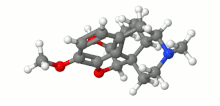Dihydrocodeine
 |
|
 |
|
| Clinical data | |
|---|---|
| AHFS/Drugs.com | International Drug Names |
| Pregnancy category |
|
| Dependence liability |
Moderate-high |
| Addiction liability |
Moderate-high |
| Routes of administration |
|
| ATC code | |
| Legal status | |
| Legal status |
|
| Pharmacokinetic data | |
| Bioavailability | 20% |
| Metabolism | |
| Biological half-life | 4 hours |
| Identifiers | |
|
|
| Synonyms | 6α-Hydrocodol |
| CAS Number | |
| PubChem CID | |
| IUPHAR/BPS | |
| DrugBank | |
| ChemSpider | |
| UNII | |
| KEGG | |
| ChEMBL | |
| ECHA InfoCard | 100.004.303 |
| Chemical and physical data | |
| Formula | C18H23NO3 |
| Molar mass | 301.38 g/mol |
| 3D model (Jmol) | |
|
|
|
|
|
|
|
Dihydrocodeine is a semi-synthetic opioid analgesic prescribed for pain or severe dyspnea, or as an antitussive, either alone or compounded with paracetamol (as in co-dydramol) or aspirin. It was developed in Germany in 1908 and first marketed in 1911.
Commonly available as tablets, solutions, elixirs, and other oral forms, dihydrocodeine is also available in some countries as an injectable solution for deep subcutaneous and intra-muscular administration. As with codeine, intravenous administration should be avoided, as it could result in anaphylaxis and life-threatening pulmonary edema. In the past, dihydrocodeine suppositories were used. Dihydrocodeine is available in suppository form on prescription.
Dihydrocodeine is used as an alternative or adjunct to codeine for the aforementioned indications. It is available as the following salts, in approximate descending order of frequency of use: bitartrate, phosphate, hydrochloride, tartrate, hydroiodide, methyliodide, hydrobromide, sulfate, and thiocyanate. The salt to free base conversion factors are 0.67 for the bitartrate, 0.73 for the phosphate, and 0.89 for the hydrochloride.
Dihydrocodeine was developed during the intense international search for more effective antitussives, especially to help reduce the airborne spread of tuberculosis, pertussis, pneumonia, and similar diseases, in the years from c.a. 1895 to 1915. It is similar in chemical structure to codeine. Dihydrocodeine is twice as strong as codeine. Although dihydrocodeine does have extremely active metabolites, in the form of dihydromorphine and dihydromorphine-6-glucuronide (one hundred times more potent), these metabolites are produced in such small amounts that they do not have clinically significant effects.
Dihydrocodeine is also the original member and chemical base of a number of similar semi-synthetic opioids such as acetyldihydrocodeine, dihydrocodeine enol acetate, dihydroisocodeine, nicocodeine, and nicodicodeine.
...
Wikipedia
